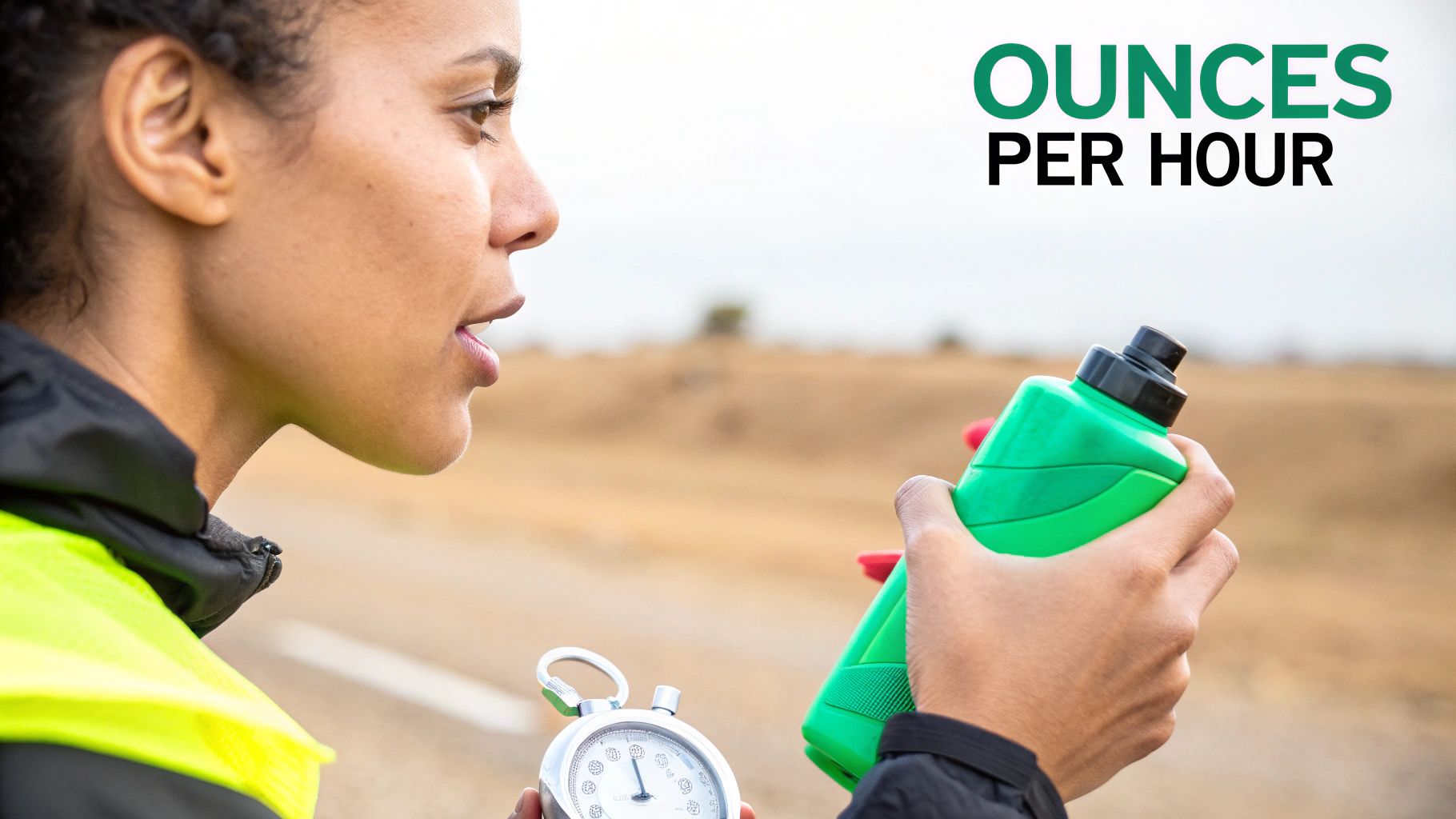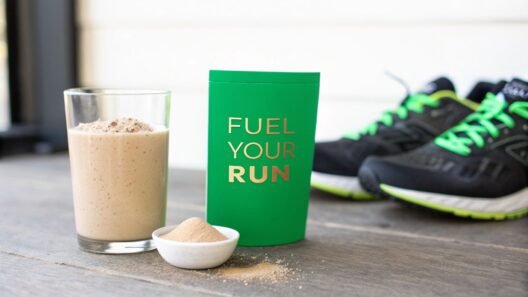Figuring out how to carry water on a run can completely change your experience. It really comes down to three main choices: a handheld bottle for shorter jogs, a hydration belt for those middle distances, or a hydration vest when you're going long. Each one strikes a different balance between how much it holds, how comfortable it feels, and how easy it is to use.
Why Carrying Water Is a Non-Negotiable for Runners
Proper hydration isn't just a suggestion; it's what fuels your performance. It impacts everything from how energetic you feel to how quickly you bounce back after a run. As you clock the miles, your body sweats to cool down, and that process drains your fluid levels fast.
Even a little bit of dehydration can tank your performance, bringing on fatigue, muscle cramps, and making it hard to focus. This goes way beyond just feeling thirsty. You're trying to keep your body in balance. Staying hydrated helps control your body temperature, keeps your joints moving smoothly, and delivers vital nutrients to your muscles. It's the oil in your engine—without it, everything starts to seize up.
Key Performance Benefits of Staying Hydrated
Think of carrying water as a strategic move, not just a chore for hot days. When you get your hydration right, the benefits are almost immediate.
- Sustained Energy: When you're properly hydrated, your blood volume stays consistent. That means oxygen gets to your muscles more efficiently, which helps keep that dreaded wall of fatigue at bay.
- Improved Recovery: We all know chugging water after a run is important, but sipping during the run gives you a serious head start. It helps cut down on muscle soreness and kick-starts the repair process sooner. For more on this, see our guide on what to eat before a run.
- Better Thermoregulation: Staying hydrated helps your body sweat the way it's supposed to. This is your built-in cooling system, and it's crucial for preventing overheating and holding your pace, especially when the temperature climbs.
To help you decide, here’s a quick breakdown of the most popular options.
Running Hydration Methods at a Glance
| Method | Best For | Typical Capacity | Main Advantage |
|---|---|---|---|
| Handheld Bottle | Short to mid-distance runs (3-10 miles) | 10-20 oz | Simplicity and quick access |
| Hydration Belt | Mid to long-distance runs (6-20 miles) | 12-40 oz | Hands-free running with storage |
| Hydration Vest | Long runs & ultramarathons (15+ miles) | 1.5-2.5 liters | High capacity and balanced weight |
Ultimately, finding the right hydration system is key to making it a seamless part of your run.
The goal is to find a hydration system that feels like a natural extension of your body. The best way to carry water while running is the method you forget you're even wearing, letting you focus entirely on the road ahead.
By making hydration a core part of your running routine, you'll shift from just getting through your runs to actually getting the most out of them. Let's dive into the specifics of handhelds, belts, and vests to find the perfect fit for you.
Finding Your Perfect Hydration Gear
Choosing how to carry water on a run isn't just about grabbing a bottle. It's about finding a system that works with your body, your running style, and how far you’re going. The right gear feels like it's not even there, but the wrong choice? That’s a one-way ticket to annoying sloshing, chafing, and general misery that takes your head out of the run.
Let's walk through the three main ways runners carry water—handheld bottles, hydration belts, and vests—so you can figure out which one is your perfect match.
More and more, runners are realizing just how critical on-the-go hydration is, and the gear market reflects that. The global market for running water bottles was valued at around $500 million in 2023 and is expected to climb to nearly $850 million by 2033. This boom is all thanks to runners like us demanding better, lighter, and truly leak-proof options. You can read more about the running bottle market trends to see what’s driving these innovations.
Comparing Handhelds, Belts, and Vests
To make sense of it all, it helps to see the options side-by-side. Each one has its place, and what works for a quick 5K is definitely not what you want for a 50K. This table breaks down the key differences to help you narrow down your choice based on what matters most to you.
| Feature | Handheld Bottles | Hydration Belts | Hydration Vests |
|---|---|---|---|
| Best For | Short runs (3-10 miles), races with frequent aid stations | Medium to long runs (10-20 miles), marathon training | Long runs (20+ miles), trail running, ultramarathons |
| Capacity | Low (8-20 oz) | Medium (12-40 oz) | High (1-2.5+ Liters) |
| Comfort | Can cause hand fatigue; may create an imbalance | Can bounce or chafe if not fitted properly | Most comfortable when fitted well; distributes weight evenly |
| Accessibility | Easiest and quickest access to fluids | Easy access to bottles in holsters | Very easy access to front flasks or drinking tube |
| Storage | Minimal; maybe a small pocket for a key or gel | Moderate; pockets for phone, keys, fuel | Ample; multiple pockets for layers, food, safety gear |
| Hands-Free? | No | Yes | Yes |
Ultimately, the "best" option is the one that disappears when you're running. A handheld is perfect for simplicity on shorter runs, a belt offers a great middle ground for marathon training, and a vest is the undisputed champion for epic adventures where you need to carry everything with you.
Handheld Bottles: The Simple Solution
For shorter distances, say anywhere from 3 to 10 miles, a handheld bottle is often all you need. It’s the most straightforward way to carry water, perfect for just getting a few sips in to stay topped off. And we've come a long way from just clenching a disposable plastic bottle for miles.
Today's running handhelds are ergonomically shaped to fit the curve of your hand and almost always come with an adjustable strap. That little strap makes all the difference—it means you can relax your hand instead of maintaining a death grip, which goes a long way in preventing cramps and fatigue.
- The Good: They’re light, incredibly easy to use and clean, and give you the absolute fastest access to your water.
- The Bad: It ties up one of your hands, which can feel awkward or throw off your balance. Capacity is also pretty limited, usually topping out around 20 ounces, making them a no-go for long runs without a place to refill.
A great innovation here is the soft flask. These collapsible bottles shrink as you drink, which completely eliminates that annoying water sloshing. When it's empty, you can just scrunch it up and stick it in your pocket.
Hydration Belts: Hands-Free Freedom
Once your runs start getting longer and you need more water than a single bottle can offer, a hydration belt is a fantastic step up. You get to keep your hands free for a natural arm swing while carrying more fluid and usually a few other essentials.
Most belts are designed to hold one to four small bottles (typically 6-10 ounces each) in little holsters around your waist. The secret to loving your hydration belt—and not wanting to throw it in a ditch—is getting the fit just right to stop it from bouncing.
Pro Tip: Wear the belt low across your hips, not up high on your waist. When you cinch it snugly over the top of your hip bones, you give it a solid anchor point that pretty much eliminates that vertical bounce when you run.
A classic mistake is wearing the belt too loosely because you're worried it'll feel too tight. A good fit should be snug enough that it doesn’t move, but not so constricting that you can't breathe deeply.
This decision tree gives you a quick visual on which option might be best based on how long you typically run.

As you can see, your gear choice really should scale with your time on feet. The goal is always to carry what you need without being weighed down by what you don't.
Hydration Vests: The Ultimate Endurance Tool
For the long-distance crowd, trail runners, and ultramarathoners, the hydration vest is the undisputed king. It’s pretty much non-negotiable for any run lasting over 90 minutes or on routes where aid stations are a distant dream.
Think of a vest less like a backpack and more like a piece of clothing. It's designed to hug your torso, spreading weight evenly across your chest, shoulders, and back for incredible stability and comfort. No bouncing here.
Vests offer the biggest fluid capacity, usually carrying between 1.5 to 2.5 liters. This is typically handled in one of two ways (and often both at the same time):
- Front-Mounted Soft Flasks: Two flasks, usually 500ml each, sit in pockets on the chest straps. This gives you super easy access to a quick drink without breaking your stride.
- Rear Hydration Bladder: A larger reservoir sits in a sleeve on your back, with a drinking tube that you can clip to your shoulder strap for hands-free sipping.
A common setup I love is putting my electrolyte drink in the front flasks and plain water in the back bladder. It gives you options on the fly. Vests are also loaded with pockets, giving you a place for everything: gels, your phone, keys, and even a rain jacket. When you're picking one out, focus on fit above all else. It should feel snug, with adjustable side and chest straps you can tweak to lock it down and prevent any movement or chafing.
Calculating How Much Water You Really Need
Figuring out how much water to bring on a run isn't an exact science—it's more of an art you learn through experience. There's no single magic number. Your body's needs can swing wildly depending on the distance, the intensity, and what the weather is doing that day.
A good rule of thumb for runs lasting over an hour is to plan on drinking 7-10 fluid ounces (about 200-300 ml) every 15-20 minutes. But think of that as a starting point, not a strict rule. The real trick is learning to listen to your body and adapt on the fly.

Adjusting for Your Specific Run
Let's get practical. A cool, breezy 45-minute jog on flat ground? You probably don’t need to carry any water, assuming you were hydrated before you headed out. Your body can handle that just fine.
But a 90-minute trail run in the summer heat? That's a completely different game. The brutal combination of heat, humidity, and tough climbs sends your sweat rate through the roof. On a run like that, you'll need a lot more fluid—and you'll want to be on the higher end of that 7-10 ounce recommendation. It's also a great idea to add electrolytes to replace all the salt you're sweating out. The calorie burn is way higher, too; you can get a good estimate with a running calorie calculator to help dial in your entire fueling plan.
Your thirst is a decent guide, but it's always playing catch-up. By the time you feel parched, you're already behind on hydration. The goal is to drink ahead of your thirst—small, frequent sips are the way to go.
The Dangers of Getting It Wrong
Most of us worry about not drinking enough, but it's also possible to drink too much. Over-hydration, also known as hyponatremia, happens when you down so much plain water that you dilute your body's sodium levels to a dangerous point.
It's all about finding that balance. Here’s what you need to watch out for:
- Dehydration: This is the one we all know. It brings on fatigue, muscle cramps, dizziness, and a skyrocketing heart rate. Your performance will fall off a cliff.
- Over-hydration (Hyponatremia): This can cause confusion, nausea, and headaches. In serious cases, it can be life-threatening. This is a bigger risk in longer events like marathons, where people sometimes panic and chug too much water at every aid station.
The real key is to practice and pay attention during your training runs. You’ll start to develop an intuition for what your body needs in different conditions. This is how you build a smart, personalized hydration plan that keeps you safe and running strong.
How to Run Without Bounce or Chafing
The best hydration gear is the gear you forget you're wearing. But when your pack starts bouncing or a strap starts rubbing, it’s not just annoying—it can completely derail a run. Getting the fit right is the secret to making your water bottle, belt, or vest feel like a natural extension of your body.

It’s often the smallest tweaks that make the biggest difference. The goal is a snug, stable fit that moves with you, not against you.
Eliminating Bounce from Belts and Vests
Bounce is the number one complaint I hear about hydration gear, but it's almost always fixable. With hydration belts, the trick is all about placement. Many runners make the mistake of wearing them too high, up around their actual waist, where there's nothing for the belt to really grip.
Instead, try positioning the belt low across your hips. You want it to rest right on the top of your hip bones, using that bony shelf as a natural anchor. Cinch it down snugly—probably tighter than you think you need to. It shouldn't feel like it's squeezing the life out of you, but there should be zero slack for it to move around.
Hydration vests are a different beast and need a more methodical approach to get that perfect "second-skin" feel. Here’s a little system that works every time:
- Start with the Side Straps: Before you even touch the front clips, pull the straps under your arms tight. You want the vest to sit completely flush against your back and ribs with no gaps.
- Finish with the Chest Straps: Once the sides are secure, cinch the front chest straps. This is the final step that locks the front flasks down and stops them from jiggling.
Preventing Painful Chafing
Nothing ruins a post-run shower like discovering angry red chafe marks. This misery is caused by repetitive friction between your gear and skin, and it gets a whole lot worse when you add sweat to the mix.
Your first line of defense is your clothing. Ditch the cotton. A heavy, sweat-soaked cotton shirt is basically sandpaper. Stick to moisture-wicking technical fabrics that pull sweat away from your skin. With vests, double-check that all your straps are lying flat and haven’t gotten twisted.
One of the most effective, yet often overlooked, tools is a good anti-chafe balm. Seriously, this stuff is a game-changer. Before you head out, apply it generously to any potential hot spots—under your arms, along your collarbones, or on your lower back where a belt sits. It creates a smooth, protective barrier that lets the gear glide over your skin instead of rubbing it raw.
Building Your Race Day Hydration Strategy
If there's one golden rule in running, it’s this: nothing new on race day. This goes for your shoes, your breakfast, and it absolutely goes for how you plan to carry water. Your hydration strategy shouldn't be an afterthought; it needs to be a well-rehearsed routine that feels like second nature when the starting gun goes off.
The time to dial in your gear is during those long training runs, not at the starting corral. This is your chance to practice everything. Can you sip from your flask without losing your rhythm? How easy is it to unscrew a bottle cap with tired, sweaty hands? These little things feel surprisingly monumental when you're deep into a race.
Planning for the Big Day
How you approach hydration on race day really comes down to your game plan. You’ve got three main options, and the best one for you depends on the race distance, how much you personally need to drink, and what the course offers.
- Be Self-Sufficient: This means you carry everything you need from start to finish. It’s a popular method for trail runners or anyone who relies on a specific drink mix. A good hydration vest is usually your best friend here.
- Rely on Aid Stations: You carry nothing and grab what you need from the tables along the course. This can work perfectly for shorter races or for runners who are fine with whatever water or sports drink is on offer.
- Use a Hybrid Approach: This is what most runners do. You’ll carry a smaller handheld bottle or a waist belt to sip from between the official stops, then use the aid stations to refill your bottle or grab a quick cup.
The key is to integrate this practice into your training. If you're working through a structured program, like this 12-week 10K training plan, use those weekly long runs as your dress rehearsal.
Your goal is to make hydrating so automatic that it takes zero mental energy on race day. All your focus should be on your pace and effort, not fumbling with your gear.
Maintaining Your Gear for the Long Haul
Think of your hydration gear as a long-term investment. Taking good care of it not only extends its life but also keeps it hygienic. Trust me, the last thing you want is a funky-tasting bottle or a bladder harboring bacteria that could lead to stomach issues mid-race.
After every single run, give your bottles, flasks, and bladders a good rinse with warm, soapy water. For a deeper clean—especially for bladders—use a cleaning tablet or a mix of lemon juice and water to keep mildew away. A long, skinny brush is a must-have for scrubbing out drinking tubes where moisture loves to hide.
This focus on clean, reusable gear is part of a bigger picture. The global reusable water bottle market was valued at around USD 9.0 billion in 2023 and is only expected to grow as more people focus on sustainability. By choosing durable, reusable options, we're not just helping our running; we're making a smarter choice for the planet.
Before you put anything away, make sure it's completely, bone-dry. This simple step ensures everything stays fresh and ready for your next run.
Common Questions About Carrying Water
Even after you've picked out your gear, you'll probably have a few questions once you start logging miles. Let's tackle some of the most common things runners ask about carrying water so you can hydrate without any hassle.
Can I Just Carry a Regular Plastic Water Bottle?
You can, but I wouldn't recommend it. A standard disposable bottle forces you into a death grip just to hold on, which tires out your hand and can mess with your arm swing and running form.
Plus, the constant sloshing sound is just plain annoying. Running-specific bottles are designed with hand straps, ergonomic shapes, and easy-to-use bite valves for a reason—they solve these problems and make for a much more comfortable run.
How Do I Properly Clean a Hydration Bladder?
Keeping your bladder clean is non-negotiable if you want to avoid that funky, mildew taste. After most runs, a quick rinse with warm, soapy water will do the trick.
For a more serious deep clean, drop in a cleaning tablet or use a mix of water with a splash of lemon juice. The real secret weapon, though, is a long, flexible brush for scrubbing out the inside of that drinking tube where gunk loves to hide.
The single most important step is ensuring the bladder dries completely. Prop it open—some cleaning kits come with a hanger—so air can circulate inside. This simple habit prevents mildew growth and keeps your water tasting fresh.
Should I Carry Sports Drinks or Just Water?
This really comes down to how long and hard you're running. If you're out for less than an hour, plain old water is all you need to stay hydrated.
But once you start pushing past 60-90 minutes, or if it's brutally hot and humid, a sports drink is a great idea. It does two things water can't: it replaces critical electrolytes (like sodium) that you're sweating out, and it gives you a quick hit of carbs for energy. Just make sure you test out any new drink on a training run first to see how your stomach handles it—race day is not the time for surprises.
Technology is also stepping in to help. The smart water bottle market, currently valued at USD 40.03 billion, is growing fast. These bottles use sensors and apps to track what you drink and even ping you with reminders. You can read more about the growth of the smart water bottle market and see how it’s shaping personal hydration.
At THE RUNNING, we provide the expert guides and training plans you need to run smarter and stronger. Explore our resources to perfect every part of your run at https://www.the-running.com.








